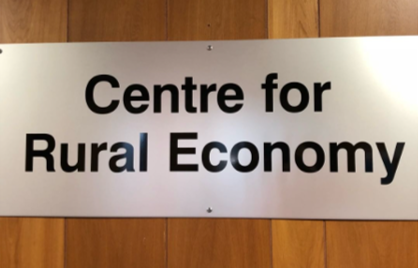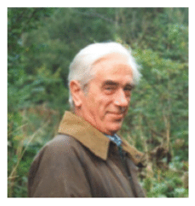With the Centre for Rural Economy fast approaching its 30th birthday next year, Emeritus Professor Christopher Ritson recounts the 25 years of social science agriculture, food and the rural economy prior to the centre’s establishment.

In this first Blog I want to put on record the string of events over a period of 25 years which led to the establishment of the Centre for Rural Economy (CRE). In Part II, I take a more light-hearted look at life in the Agriculture Building 50 years ago.
Where did it all begin?
Oddly, it started with the arrival of Agricultural Marketing at Newcastle. During the 1950s, the UK moved rapidly from early post-war food shortage and rationing, in which the policy priority was increasing output and improving the productivity of domestic agriculture, to the problem becoming declining and unstable farm product prices. The challenges of this period were reminiscent of those faced in 1930s, which had led to the establishment of Marketing Boards for most agricultural commodities.
In this context, the Ministry of Agriculture, which had developed the network of farm business data collection based in agricultural economics departments throughout the country, decided that agricultural economics research needed to move away from concentrating on farm production economics towards studying the economics of post-farm gate markets. In the early 1960s, it financed the creation of a Chair and Department of Agricultural Marketing at King’s College, Newcastle (then part of Durham University, but soon to become independent as the University of Newcastle upon Tyne). Here is an extract from the press release issued under the name of the Rector of King’s College, Charles Bosanquet:
“Experience has convinced both the Ministry and King’s College that there is an extreme shortage of economists adequately trained to study distribution economics, and that the changes in the agricultural policy of the UK that may be expected will make it desirable to build up studies in marketing to the point at which they at least equal the national effort in production economics.”
Why Newcastle was chosen for this substantial investment is something of a mystery, as there were, at the time, around a dozen agricultural economics centres throughout the UK with a more distinguish academic profile than Newcastle. (I can offer one explanation, albeit based only on anecdotal evidence. For this you will have to wait for Part II of this blog.)
Agricultural Adjustment
This was the first step in the journey towards the broader study of the rural economy – the application of “economic principles to the problems of identifying and satisfying the needs and preferences of consumers, by the most effective use of markets, processing plants, transport, advertising, and retail outlets.” (Again, from the Bosanquet press release.)
In parallel with this was the view that the structure of farming itself needed to “adjust” to the way agricultural product markets and consumer food demand were evolving. So, just a few years after the Ministry of Agriculture’s finance of agricultural marketing at King’s College, there was a second massive investment, this time by the Kellogg Foundation, to establish the Agricultural Adjustment Unit (AAU). The Grant was secured by the recently appointed Professor of Agricultural Economics, John Ashton (more of this in Part II), and provided five years funding for six research associates, together with support staff.
The upshot was that over a period of 10 years, from the early 1960s to the early 1970s, agricultural economics at Newcastle was transformed from something of a backwater into one of the leading UK centres for social science research related to agriculture, food and the rural economy.
Agricultural Marketing at Newcastle was awarded the top grade in the first national Research Assessment Exercise. However, the main legacy of the agricultural marketing initiative turned out to be in teaching. The Chair in Agricultural Marketing is reputed to be the first anywhere in Europe with the word “marketing” in its title. The Department’s MSc in Marketing (note, just “marketing”, not agricultural marketing) was the first marketing degree in the UK, and the BSc Agricultural and Food Marketing, the first “marketing” undergraduate degree. Gradually, marketing came to dominate “agriculture and food” with many new teaching initiatives, most of which have now been transferred to the Business School.
The baton for meeting the Ministry requirement for agricultural economics research to support “the changes in agricultural policy in the UK that may be expected” was, in part, picked up by three members of staff in the Agricultural Economics department, Ken Thompson, Allan Buckwell, and David Harvey, who together published a book on the subject, titled “The Cost of the Common Agricultural Policy” (1982). Soon all three were to leave for Chairs at Aberdeen, Wye College, and Reading respectively, though David was only on loan to Reading for a few years!
Countryside Change

Perhaps the most important step on the path towards the creation of the CRE itself was the work of Martin Whitby. Martin was a lecturer in agricultural economics during the time of the AAU, and a major contributor to its output. Part of the “adjustment” envisaged for the agricultural sector concerned rural employment and labour migration, and this was Martin’s area of expertise. When the funding for the AAU ended, Martin carried his interest forward with a sort of “slimmed down” version of it.
The AAU eventually became the Countryside Change Unit (CCU), following a successful bid to a call from the ESRC in 1987 by Martin and David Harvey (by then back at Newcastle) for research into the changing nature of the British countryside. The ESRC funded two centres in response to their call, the CCU at Newcastle (three full time researchers for five years – of whom one was current CRE director Guy Garrod), and a similar unit at University College London (UCL), co-led by Philip Lowe.
The creation of the CRE
When the Chancellor of Newcastle University, the Duke of Northumberland, died in 1988, a funding appeal was launched in his memory. A blueprint for a “Centre for Rural Economy”, written by Martin Whitby, was put forward from the Faculty of Agriculture in response to a university-wide invitation for proposals for the funding raised. Given the dominance of the Medical School at Newcastle, it was expected that funds from appeals of this kind would usually finance medical research. However, Martin’s proposal struck a chord with the land-owning Northern contributors to the Duke of Northumberland Appeal, and the proposal to create a Centre for Rural Economy was the successful application.
That the Centre would be located in the Faculty of Agriculture (then in the process of becoming the larger Faculty of Agriculture and Biological Sciences) was not a foregone conclusion. The Head of the Department of Geography, John Goddard, put forward an academic case for the Centre to be in Geography as part of, or at least alongside, the high-profile Centre for Urban and Regional Development Studies (CURDS). However, the Agriculture Dean, Keith Syers (the Head of a faculty was then called “The Dean”) told me that the message coming from the major donors to the appeal fund was that they regarded it as “unthinkable” that the Centre would not be located “in Agriculture”.
Nevertheless, Geography was accorded a role in the establishment of the CRE. John Goddard and I (at the time, head of the recently merged Department of Agricultural Economics and Food Marketing) jointly undertook a series of informal interviews with long-list candidates for what had become designated as “The Duke of Northumberland Professor of Rural Economy”. Four candidates went forward for final interview. The successful candidate was the Director of the UCL CCU, Philip Lowe. In addition, a personal Chair was also secured for Martin Whitby.
Thus, the CRE was born. In Part II I take a more light-hearted look at life in the Agriculture Building 50 years ago.

Thank you Chris for a very interesting account of the history of Agricultural economics and Marketing here in Newcastle. It is important for us to know and reflect on this history to propel us to the future. I would like to know more about other parts of this story, namely how did the Agribusiness degree came to be. I also would like to learn more about the 90’s and early XXI century, as there are quite a colleagues that I heard about throughout the years that have been trained or taught and researched at Newcastle before moving to other places. It would be really important to try to re-established those ties as they can help us rebuild and re-establish our reputation and influence in the field Agro-Food economics and marketing for the future.